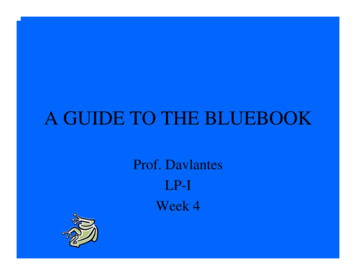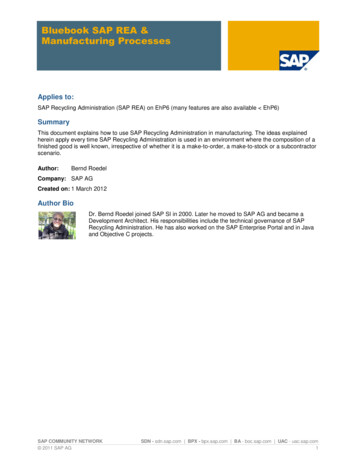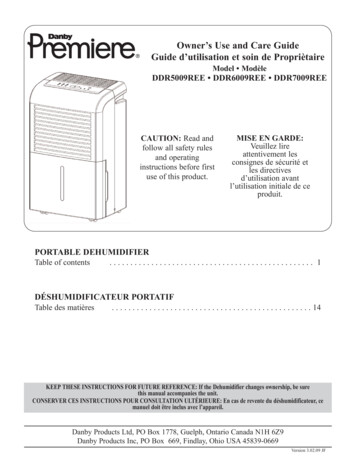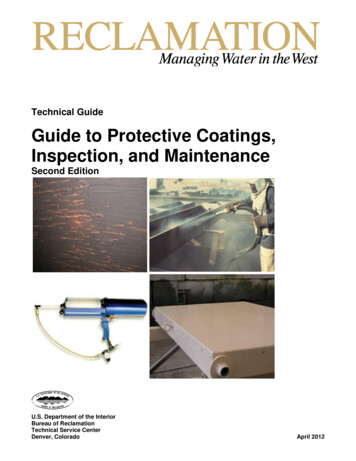
Transcription
A GUIDE TO THE BLUEBOOKProf. DavlantesLP-IWeek 4
Navigating the Bluebook Quick References (at front and back)Practitioner’s Notes (blue pages in front)Rules (white pages in middle)Tables and Abbreviations (blue pages inback) Index (white pages in back)
You Must Cite to SupportingAuthority When: You make anassertion about thelaw You quote directlyfrom a legal source You paraphrase froma legal source
Citation of American Case Law Federal cases: TheSupreme Court of theUnited States is theonly federal court toofficially report itscases. This reporter isthe United StatesReports (U.S.) The Bluebook requirescitation only to theofficial report Supreme Court Opinions arealso published in threeunofficial reporters:1. Supreme Court Reporter(S. Ct.)2. Lawyer’s Edition (L. Ed.)Lawyer’s Edition, SecondSeries (L. Ed. 2d)3. United States Law Week(U.S.L.W.)
Citations of Federal Cases, cont. Federal courts of appealdecisions are published byWest in the unofficialreporter, Federal Reporter2d and 3d (F.2d and F.3d). District court decisionsare published by West inthe unofficial reporter, theFederal Supplement (F.Supp.)
State cases & West RegionalReporters 28 states publish their cases officially. The other 22 states rely on the unofficialWest reporters to publish their cases inseven regional reporters:––––––North Eastern (N.E. and N.E.2d)North Western (N.W. and N.W.2d)Pacific (P. and P.2d)South Eastern (S.E. and S.E.2d)South Western (S.W. and S.W.2d)Southern (S. and S.2d).
New York and California are Odd The intermediate courtdecisions of thesestates are alsopublished by West inthe New YorkSupplement (N.Y.S.and N.Y.S.2d) and inthe CaliforniaReporter (Cal. Rptr.),respectively.
How to Cite CasesJackson v. Green, 204 So. 2d 94 (Fla. 1974)case name reporter (volume, reporterabbrev., page #) court and date
Underlining or Italicizing Case Names In briefs, memos, and other legalwritings, all case names andprocedural phrases should beitalicized or underscored. In thisclass, always underline. The “v.”should also be underscored.Iinclude blank spaces between thewords and the case name. Incorrect: Jones v. SmithIn re Jones Correct: Jones v. SmithIn re Jones
Cite only the first listed party oneach side John P. Jones, Franklin W. Bailey,Plaintiffs v. Glenn M. Adams, andStephen Lamieux, Defendants– Jones v. Adams If two or more cases are consolidated, citeonly the first-listed parties of each side ofthe first-listed action.
Cite individuals by last name only Do not include “et. al.” to show multiple parties;no first names or initials; no “d/b/a” or “a/k/a”;do not include legal status such asAdministrator, Executor, Plaintiff, Defendant,Appellant, Appellee, Guardian, etc.CorrectIncorrectSmith et. al. v. JonesSmith v. JonesJohn E. Smith v. Jill JonesSmith v. JonesSmith d/b/a Flower PowerSmith v. Jonesv. Jones
Business Names If a business uses more than one businessterm in its name, drop all but the first.Incorrect:Pacific Palisades Co., Inc. v. A.V. JonesCorrect:Pacific Palisades Co. v. Jones
Citing a Decision Involving a State To cite a state, use either the word “State,”“Commonwealth,” or “People,” depending onwhich appears on the title page, if citing to a casedecided by that state’s state court. Use the name ofthe state if citing to a case not decided by thatstate’s state court. Never use both. Ex: The State of Arizona v. Jonathan P. Jones If case cited by Arizona court, then: State v. Jones If cited by another court: Arizona v. Jones
Citing a City in a Case Name To cite a city or county, cite itthe way it appears on the titlepage. Omit name of statethough. Incorrect: City of Memphis,Tennessee v. Jonathan P. Jones Correct: City of Memphis v.Jones
When United States is a Party United States ofAmerica is alwayscited as “UnitedStates”– not U.S.A.– not U.S.– not United States ofAmerica– not the big Red, Whiteand Blue
Titles of government officials Cite only to the person’s last name and omitthe title completely.Incorrect: Harris, Secretary of the Departmentof Health and Human Services v. CiticorpCorrect: Harris v. Citicorp Exception: Commissioner of Internal Revenue.Incorrect: Commissioner of Internal Revenue v.Fred C. SmithCorrect: Commissioner v. Smith
In rem actions Actions involving objects such as land or goodsare known as “in rem” actions.Ex.: condemnation proceedings or proceedingsagainst contraband property. Omit all but firstlisted item or group of items. Incorrect: In re Fifty Kilograms of Cocaine,Twelve Cases of Potato Chips, and One MilkyWay Bar Correct: In re Fifty Kilograms of Cocaine
When Real Property is a Party When real property is a party, use its streetaddress and omit all other words. Incorrect: United States v. Real PropertySituated at 13 Fernbank Lane, County ofDuval, State of Florida Correct: United States v. 13 Fernbank Lane
Use of “the” in party names Omit “The” as the first wordof a party’s name unless theparty’s name is “The King,”“The Queen,” or the name ofan object in an in-rem action. Incorrect: The Heekin Co. v.Fred Franklin Correct: Heekin Co. v.Franklin
Prepositional Phrases of Location Omit prepositional phrases oflocation unless the resultingcitation leaves only one word inthe case name or aninsufficiently identified casename. Incorrect: Brown v. Board ofEducation of Albemarle County Correct: Brown v. Board ofEducation
Abbreviations: The Bluebook has two differentsystems for abbreviating: Heavy and Light. The Light Abbreviation System is used forcase names appearing in the grammatical part of textualsentences and in complete sentences in footnotes. (Rule10.2.1) Only eight words are abbreviated:Company Co.Corporation Corp.Incorporated Inc.Limited Ltd.Number No.And &Association Ass’nBrothers Bros.C Any widely known acronym may also be used, e.g.,National Labor Relations Board NLRB.
The Heavy Abbreviation System All words in case names, other than the firstword of either party’s name, is abbreviated if itis listed in Table 6 on pages 302-03 of theBluebook (Rule 10.2.2). Used for case names appearing in citations, i.e.,one that is not part of a grammatical sentence. Ex: Although it is generally recognized that landlords have aduty to protect tenants against foreseeable third party criminalattacks, see, e.g., Isaacs v Huntington Mem’l Hosp., 695 P.2d653 (Cal. 1985), the court in Ann M. v. Pacific Plaza ShoppingCenter, 863 P.2d 207 (Cal. 1993), restricted this liability byrequiring the application of a balancing test.
Forming abbreviations The Bluebook uses two methods of abbreviatingwords.– The contraction technique takes the first threeletters of a word plus the last letter. Anapostrophe is used before the last letter but noperiod.Ex: “department” is abbreviated “dep’t”, not“dept.”– The scrunched technique is used when variousletters of the word are chosen as theabbreviation. Use a period at the end.Ex: “building” is abbreviated “bldg.”
Procedural Phrases “Ex rel.” is the abbreviation for “on the relationof,” “for the use of,” “on behalf of,” and similarexpressions. This type of proceeding occurs when one party issuing on behalf of another. (Rule 10.2.1(b)) Ex: James P. Smith, Attorney General for the Stateof Mississippi, for the use of Jane P. Jones v. FredJones is cited as Smith ex rel. Jones v. Jones.
Procedural Phases “In re” is the abbreviation for “in the matterof,” “petition of,” “application of,” and thelike. These cases might involve the probate of awill or a bankruptcy proceeding. Ex: In the Matter of the Will Jane L. Lesteris cited In re Will of Lester.
Parallel Citation Rule (PC Rule) When citing a given state’s cases to thatstate’s courts, always provide parallelcitations to the official and unofficialreports. Cite the official report first andthen the unofficial West reporter. In allother documents, however, do not provideparallel citations. Cite only to the officialWest reporter.
Examples of PC Rule Incorrect (PC Rule):123 S.E.2d 115, 217 Ga. 234 (1971) Correct (PC Rule):217 Ga. 234, 123 S.E.2d 115 (1971) Incorrect (No PC Rule):123 S.E.2d 115, 217 Ga. 234 (1971)217 Ga. 234, 123 S.E.2d 115 (1971) Correct (No PC Rule):123 S.E.2d 115 (Ga. 1971)
How to Cite the ParenthesesEach case citation must include the preciseidentity of the court deciding the case. Mostofficial court reports publish the opinion of justone court. Thus, when following the PC Rule, bynaming the court report, the court is alsoidentified. In the parentheses, identify the courtdeciding the case by using Table 1 of theBluebook. Ex: Jackson v. Green, 143 Va. 423, 218 S.E.2d453 (1971) PC RuleJackson v. Green, 218 S.E.2d 453 (Va. 1971) No PC Rule
How to Cite Case History Legal writers must reveal all subsequent casehistory occurring in a higher court.Ex: Jones v. Smith, 235 F. Supp. 102 (S.D.N.Y.1965), aff’d, 312 F.2d 901 (2d Cir. 1966). Prior history is cited only if the attorney wishes toalert the reader to what happened at the lowercourt level.Ex: Jones v. Smith, 312 F.2d 901 (2d Cir. 1966),aff’g 235 F. Supp. 102 (S.D.N.Y. 1965)
Short Citation Forms Use Id. only if thereare no interveningcases Ex: The court affirmedthe judgment. Smithv. Wells, 42 So. 2d– United States v. Calandra,832 (Fla. 1999). The414 U.S. at 343plaintiffs were– Calandra, 414 U.S. at 343awarded 10,000. Id.– 414 U.S. at 343at 833. The first time you cite toa case, use its fullcitation. After that, useone of these forms ofshort cites:– Id. at 343
Citing to Secondary Authority Legal encyclopedias (Rule 15.7)Give volume-name of source-topic-sectionat page (date)Ex: 42 C.J.S. Trials § 43, at 692 (1965)
Citing to Secondary Authority Annotated Reports (Rule 16.6.5)Give author’s full name, Annotation, Titleof Annotation, volume A.L.R. (1st, 2d, 3d,4th, 5th, or Fed.) Section, at page (date)Ex: Susan Smith, Annotation, Search andSeizure Rights of the Accused, 94 A.L.R.3d§ 14, at 29 (1968)
Citing to Secondary Authority Treatises (Rule 15)Give correct volume (if more than one), full nameof the author in the same way the author cites himor herself, name of treatise (underlined), section,page, correct edition of the treatise in aparenthetical. If treatise has two authors, includethe full name of both. If treatise has more than twoauthors, cite only first listed author and include “etal.” after the first author’s full name.Ex: 1 Ken C. Davis, Administrative Law Treatise§ 6.18, at 419 (1958)
Citing to Secondary Authority Periodical Articles (Rule 16)Give author’s Full name, Title of the Article,Volume number of the law review, properlyabbreviated name of the law review, page numberwhere the article begins, and a parenthetical dateat the end.Ex: William G. Pederson, Jr., The Decline ofSeparation of Functions in Regulatory Agencies,64 Va. L. Rev. 991 (1978).
Citing to Secondary Authority Periodical Articles (continued)If the article is a Note, Comment, Case Comment,or Special Project written by a law student, thecitation should include the type of article to showthat it is a student-produced work.Ex: Miles Elmore, Note, Surviving First Year inLaw School, 18 Stan. L. Rev. 680 (1966).
Signal Words Utilize to indicate when legal authority supports aproposition, contradicts a proposition, is analogous toa proposition, or provides general backgroundmaterial. All signal words are italicized or underlinedwhen used in citation sentences or clauses. If used as the verb of a sentence, signal words are notunderlined or italicized.Ex: See is used to indicate that the authority citedclearly supports the proposition of law but does notdirectly state it.But see is used to indicate that the authority clearlysupports a proposition contrary to the mainproposition.
Signal Words, continued No signal means thecited authority:1. Directly states theproposition2. Identifies the source ofa quotation3. Identifies an authorityreferred to in text.
Pinpoint Citing The citation of a case or law review article shouldinclude the page on which the document begins.The writer may also include a specific reference tothe precise page where a quotation or legalproposition appears (pinpoint cite). In this case, thespecific page follows the beginning page. Eachpage number is separated by a comma.Ex: Jones v. Smith, 234 F.2d 12, 14 (4thCir. 1971). When multiple, non-consecutive pages are cited,these pages should be separated by commas.Ex: Jones v. Smith, 234 F.2d 12, 14, 17 (4thCir. 1971).
Citing Consecutive Page Numbers When multiple, consecutivepages are cited, the first andlast numbers should beseparated by a hyphen, andall but the last two digitsfrom the last page numbershould be dropped.Ex: Jones v. Smith, 335 F.2d756, 758-60 (2d Cir. 1973).
Citing Statutes (Rule 12) Federal StatutesTo cite an entire statute codified in the United States Code,give the official name of the act the title number Codeabbrev. § or §§ parenthetical date (and supplement, ifappropriate)Ex: Americans with Disabilities Act, 42 U.S.C.§ 12101 (1194)To cite an individual provision of the United States Code,give title number Code abbrev. § or §§ parenthetical date(and supplement, if appropriate) Publisher if citing toU.S.C.A. or U.S.C.S.Ex: 42 U.S.C. § 1983 (1984)47 U.S.C. § 303(a)-(d) (1994 & Supp.II 1996)13 U.S.C.S. § 3724 (Law. Co-op. Supp. 1990)
Bluebook Modifications Always check local court rules tosee if the Bluebook rules forcitations have been modified foryour state. For example, in Florida, DistrictCourt of Appeal decisions arecited differently than listed inTable 1.Ex: Food Lion, Inc. v. Clifford, 629So. 2d 201 (Fla. 5th DCA 1993)
Citation of American Case Law Federal cases: The Supreme Court of the United States is the only federal court to officially report its cases. This reporter is the United States Reports (U.S.) The Bluebook requires citation only to the official report Supreme Court Opin











